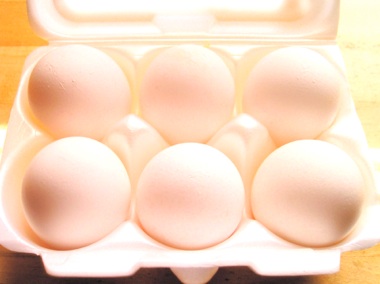


EGGS 101 back to home
Fresh is best. Eggs should be stored in the cartons they come in. This protects them from absorbing other food odors. Store them in the main body of the fridge where they are likely to stay cold vs the door of the fridge. Check expiration dates. Use only clean eggs- that are oval, and without any visible cracks.
How to tell if an egg is fresh: Put an egg in a bowl of water- if it sinks it’s fresh- if it floats it’s a stinker.
Cracking Eggs:
For a cleaner crack-break eggs on a flat surface rather than the edge of a bowl. You want to inspect the eggs for any impurities so don’t crack them into the other ingredients- put them in a bowl by themselves first.
The best way to remove unwanted shell from cracked eggs is to use part of the cracked shell itself to fish it out- it magically works like a magnet.
Scrambling Eggs:
1. Always start with a warm pan- gently warm it with a little butter. Beat the eggs very well with a fork or whisk- add a little salt and pepper a little milk or cream - about 1 t. per egg.
2. Pour the eggs into the warm pan on med- lo heat. Let them set for about 30 seconds- they will puff up some. If you start stirring right away you’ll stir the air out and you will end up with small curds and not much volume. At this point you can add other ingredients- if you want- such as, smoked salmon, onions, tomatoes, bacon, chevre, etc.
3. After the eggs have puffed- Push one edge to the center - i like using a silicone spatula- and allow the uncooked eggs to flow into the bare pan. Keep doing this until no liquid eggs flow to the edge and you have soft mounds that still look moist.
4. Eggs continue to cook after you remove them- so it’s important to remove them while still a little moist. By following these tips you will have soft, fluffy eggs, every time.
Perfect Hard-Cooked Eggs:
1. You want to avoid cracked shells and you don’t want that ugly green layer that forms around the yolk- this is caused by iron in the yolk and the sulfur in the white- heat speeds up this reaction- so the longer you cook them the chances are they will get green.
2. Place eggs in a saucepan- single layer- add enough cold water until it’s at least an inch above the eggs. Bring to a boil. Immediately turn off the heat. Cover the pot. Time for 13 minutes.
3. Run eggs under cold water to prevent further cooking. Refrigerate if not using right away- use within 3 days of cooking. Write the date in pencil on the shell.
4. Peeling a hard-cooked egg can be tricky. There is an air pocket at the pointy end so crack it there to start and try your luck. If the eggs are cold- run them under warm water- this will expand the shell for easier peeling.
Soft boiled Eggs:
1. Bring water to boil in a small saucepan- at least an inch above the egg.
2. Lower the egg into the pot with a slotted spoon. Keep heat on a gentle boil.
3. For eggs that are straight out of the fridge- cook for about 4 1/2 minutes. For room temp eggs cook for about 4 minutes.- the whites will be set and the yolks runny. The more often you do this- the better you will get at cooking your eggs to your preference.
4. Tap on the top of the small end of the egg with a butter knife handle and then take a small slice off the top. Have toast ready for dipping and plenty of salt and pepper. I like using an egg cup.
-
5.Babies love soft cooked eggs.
Perfect Omelet
1. Beat the eggs in a bowl adding some herbs, if you like,and salt and pepper. Heat the omelet pan (non-stick) over medium heat. Add the butter and let it melt. Don’t let the butter get too hot-it should sizzle but not brown. Tilt the pan in all directions to distribute the butter, then pour in the egg mixture- keeping the heat at medium. Tilt the pan again to distribute the egg mixture.
2. As the eggs begin to set at the edges, carefully push the cooked portion towards the center (i like to use a heat resistant small spatula) at the same time, tilt the pan, allowing any remaining raw egg to fill the space. Repeat. As soon as the omelet stops flowing, sprinkle the grated cheese or other fillings onto half the omelet- being careful not to overfill.
4. Cover with a lid for 30 seconds or less to hasten the cheese to melt. The egg mixture should still be a little moist -as there will be carry over cooking.
5. Using the spatula to fold the omelet in half and slide it onto the plate. Sprinkle with fine herbs. Serve immediately and pass the pepper mill.